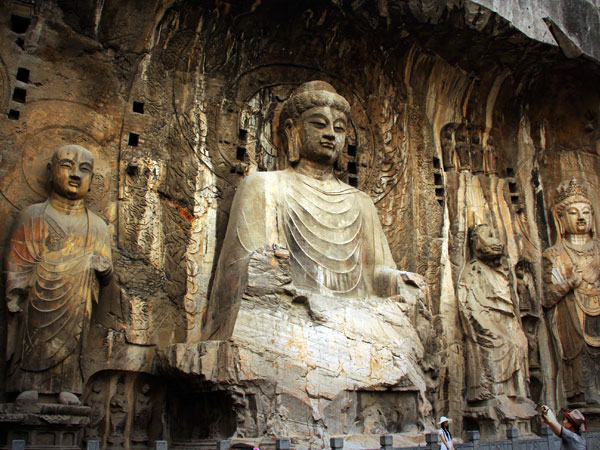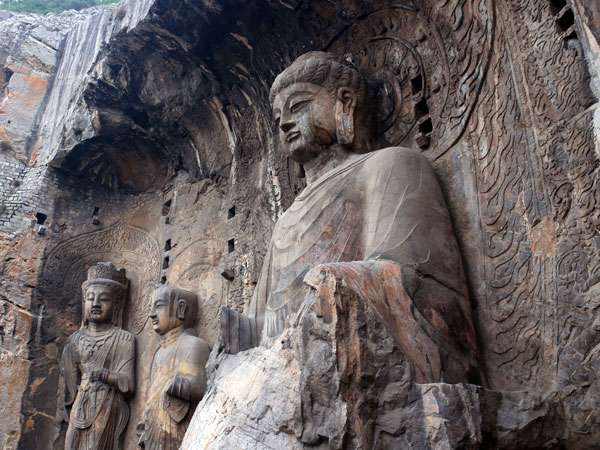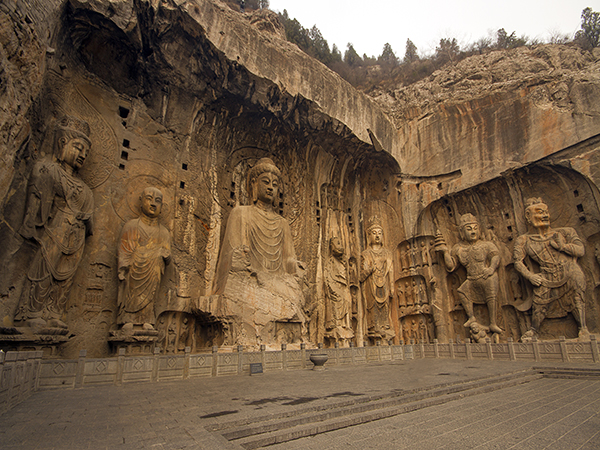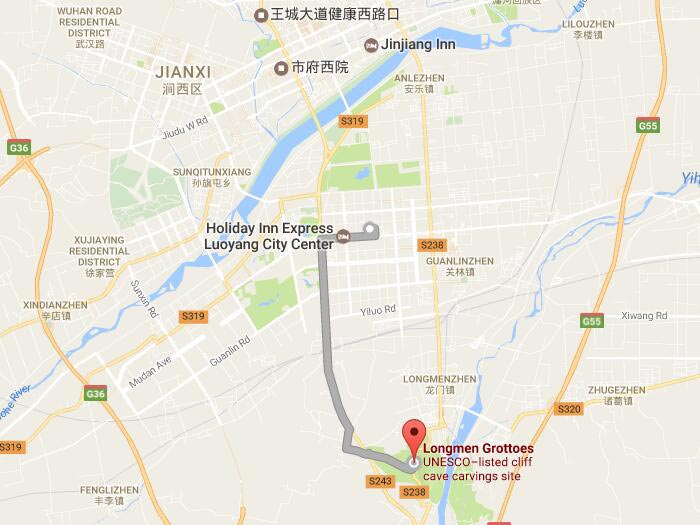The
Longmen Grottoes are located 12km south of present day Luoyang. The grottoes, which overwhelmingly depict Buddhist subjects, are densely dotted along the two mountains: Xiangshan Mountain (to the east) and Longmenshan Mountain (to the west). The Yi River flows northward between them. From north to south, the distance covered by grottoes is about 1km. There are over 2100 niches, more than 100,000 statues, some 40 pagodas and 3600 tablets and steles in the caves of Guyang, Binyang and Lianhua. Along with the Mogao Caves and Yungang Grottoes, the Longmen Grottoes are one of the three most famous ancient sculptural sites in China.
The construction of the Longmen Grottoes began in the late 5th century during the reign of Emperor Xiaowen when the Wei dynasty moved its capital from
Datong (where they created the famous Yungang Grotto) to Luoyang. At this time,
Chinese Buddhism was reaching its first peak, and the emperor was a pious believer. Carving continued after the Wei dynasty through the successive six dynasties, including Tang and Song, for a span of over 400 years and the Tang Dynasty witnessed the second peak of Buddhist belief.

There are two types of the cave sculptures that one third of them are in Northern Wei Dynasty style while two thirds of them are in Tang Dynasty style. Although this cave was built in the ancient time, the influence of the foreign culture can be found in the grotto art. This exotic culture helped the development of this
traditional Chinese art. Differences between the Northern Wei and Tang styles are also obvious. Typical Northern Wei style Buddhist statues emphasize on the simple simple and compact depictions while the cave sculptures of the Tang Dynasty are of a vigorous, elegant and realistic style. The stone statues in Fengxian Cave, carved under the edict of Empress Wuzetian (reigned 690-705), can be considered as the most typical of the period. These are composed of a 17.14-meter-high statue of Vairocana Buddha, and a series of pairs of Bodhisattvas, heavenly kings, protectors and worshippers. The huge statue of Vairocana Buddha is today praised as being the quintessence of Buddhist sculpture in China.
After 1,500 years, Longmen Grottoes is still magnificent. Its rich content reflects from different aspects the development and changes in ancient China's politics, economy, religion and culture. It has contributed tremendously to the creation and development of Chinese grotto art. On November 30, 2000, the Longmen Grottoes were approved by the 24th UN Heritage Commission to be put on the List of World Cultural Heritage.

Main Sites to See in Longmen Grottoes
【Fengxian Temple】
Fengxian Temple houses the largest and the most exquisite group of cliff-type sculptures in Longmen Grottoes area. The large art sculptures in Fengxian Temple is known for its grand scale and exquisite stone carving art and have become a model for Chinese stone carving art. It has become a symbol of this great era of the Tang Dynasty. The cave is 30 meters long and 30 meters wide. Buddhist statues in the cave shows evidently artistic characteristics of Buddhist statues of the Tang Dynasty, well-shaped with drooping ears, serene, gentle and kind.
【Qianxi Temple】
Qianxi Temple is a large cave on the northern edge of the west hill. It is 9 meters high, 9 meter meters wide and nearly seven meters deep. It was constructed about thirteen hundred years ago, during the early Tang Dynasty. On caisson of the cave is a large carved lotus. The cave has a statue of a huge, seated, early Tang Buddha (Amitabha Buddha), flanked by statues of the Bodhisattvas Avalokitesvara and Mahasthamaprapta. The statues are carved with a sophisticated expression typical of Tang style. It may have been sponsored by the Nanping princess, with the beneficiary being Gaozong, her recently deceased father.
 【Binyang Cave】
【Binyang Cave】
Binyang hole is a representative cave of the Northern Wei Dynasty. "Binyang" is intended to mean meeting the birth of the sun. Binyang caves were dig in the Northern Wei Dynasty by Xuanwu Emperor, to make making merit for his father. The construction started in 500 AD and lasted 24 years.
【Ten-thousand Buddhist Cave
It houses 15,000 Buddhas carved in small niches, different from each other, with the smallest Buddha being 2 centimetres (0.79 in) in height only. They are neatly sitting in north and south sides of the cave.
【Guyang Cave】
Guyang Cave is recorded as the oldest Longmen cave with carvings in the Northern Wei style, typically of slim and emaciated figures. It is also the largest cave located in the central part of the west hill. It was originally a natural limestone cave. Many of the sculptures inside the cave were contributed by royalty; religious groups supported this activity. The cave has three very large images - the central image is of Sakyamuni Buddha with Bodhisattvas on either side. There are about 800 inscriptions on the walls and in the niches inside the cave, the most in any cave in China. There are two rows of niches on the northern and southern walls of the cave, which house a very large number of images. Decorative carving of niches is also very beautiful, especially manifested in the design of shape, lintel and tablet of niches, colorful and varied.

How to get Longmen Grottoes from Luoyang
It is only 12 km south of Luoyang city and enjoys convenient transport. You can take Public Bus No.81 to get there direct, which takes about 45 minutes. Taking taxi should be the easiest way to get there.
 Ask a Question
Ask a Question





